
Sabatinca aurella is a species of moth of the family Micropterigidae. It is endemic to New Zealand. The larvae of this species are variable in appearance but tend to be coloured yellow-green with greyish patches. The adults of the species have a pale golden appearance with silver or purple coloured bars on the forewings. The moth has an approximate wingspan of around 1 cm. This species is found from the Coromandel Peninsula to the Fox Glacier and is on the wing from September to January. A larval host species is the liverwort Heteroscyphus lingulatus. The preferred habitat of this species is at higher altitudes than other New Zealand endemic species in this genus; and the moth tends to prefer forest or subalpine grass or scrubland.

Sabatinca lucilia is a species of moth in the family Micropterigidae. It is endemic to New Zealand and is found in the top half of the North Island. The adults of this species are on the wing from the end of November until the beginning of March. The larvae of this species likely feed on foliose liverwort species with the adults likely feeding on fern spores or sedge pollen. Adults have been found on a sunny moss-covered clay bank. The species can be found in multiple forest types such as kauri, kanuka and Nothofagus and prefers to inhabit damp fern covered banks

Sabatinca chalcophanes is a moth of the family Micropterigidae. This species is endemic to New Zealand and is found in the North Island apart from Northland and in the South Island apart from in the east, south of Queen Charlotte Sound. The adults of this species are on the wing from November to April and as a result of this long period it has been hypothesised that this species has two broods. The preferred habitat of this species is in damp lowland forest. The larval host species are foliose liverwort species including Hymenophyton flabellatum.

Zealandopterix zonodoxa is a moth of the family Micropterigidae. It is endemic to New Zealand and is located from Hawkes Bay north as well as on Poor Knights, Little Barrier and the Great Barrier Islands. It is the smallest micropterigid in New Zealand and the shiny white markings on the forewing of this species display variation. It is a moth that is active during the day, but has been collected using UV light. Adults are on the wing from September to March and the species has been witnessed visiting the flowers of Nīkau and Cordyline pumilio in large numbers. It inhabits a wide variety of moist indigenous forest but is associated with forests in which podocarps are common. Larvae have been sieved from rotten wood on the floor of a mixed podocarp/broadleaf forest or extracted from moss or from bryophytes.
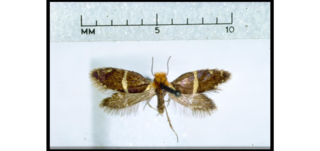
Sabatinca ianthina is a species of moth belonging to the family Micropterigidae. It was described by Alfred Philpott in 1921. It is endemic to New Zealand. This species can be found on both the North and the South Islands from the Hawkes Bay down to Westland. The adults of this species are on the wing from the end of September until the middle of December. Although this species resembles Zealandopterix zonodoxa, S. ianthina is a larger moth and the range of the two species only overlaps in White Pine Bush Scenic Reserve in the Hawke’s Bay.

Sabatinca aemula is a species of moth belonging to the family Micropterigidae. It is endemic to New Zealand and is found in the north western parts of the South Island. The larvae of this species has yet to be collected but it has been hypothesised that the larvae subsist on foliose liverworts similar to other species in the Sabatinca genus. The adults of the species are on the wing from the middle of September until the end of December. The adults of S. aemula are very similar in appearance to S. chrysargyra and it has been argued they can only be distinguished by dissection. However more recent research suggests that the colour patterns on the forewings of the two species can be sufficient to distinguish between the two species.

Sabatinca caustica is a species of moth belonging to the family Micropterigidae. It was described by Edward Meyrick in 1912. It is endemic to New Zealand and is found in both Southland and at Stewart Island / Rakiura. The adults of this species are variable in appearance with some specimens being mainly white on their forewings while others have forewings that are a more mottled purple-brown colour. Adults are on the wing from the start of October until the middle of December. Larvae feed on the surface of leafy liverworts.

Sabatinca chrysargyra is a species of moth belonging to the family Micropterigidae. It was described by Edward Meyrick in 1886 and is endemic to New Zealand. It can be found from Franz Josef Glacier / Kā Roimata o Hine Hukatere south but only on the western side of the South Island. Adults are on the wing from the beginning of October until the middle of January. Larvae likely feed on foliose liverworts and have been found on species in the genus Plagiochila. The adult moths live in a range of habitats preferring sunny open spaces in forests or snow-tussock grasslands that can range in altitude from near sea level up to 1,230 m. This species is very similar in appearance to Sabatinca aemula and dissection of genitalia is required to distinguish between the two species.

Sabatinca heighwayi is a species of moth belonging to the family Micropterigidae. It was described by Alfred Philpott in 1927 and is endemic to New Zealand. It can be found north of Lewis Pass in the north west of the South Island. Adult moths are on the wing from late September until the middle of January. The host of the larvae of this species is the foliose liverwort Plagiochila circumcincta.

Sabatinca quadrijuga is a species of moth belonging to the family Micropterigidae. This species is endemic to New Zealand and is found in the Dunedin area and in Southland. The range of S. quadrijuga overlaps with the range of S. caustica.S. quadrijuga was first scientifically described by Edward Meyrick in 1912. As a result of its predominantly black forewings this species looks similar to a small caddisfly. The adults of this species are on the wing from September to November. Larvae feed on leafy liverwort species and the adults likely feed on fern spores or sedge pollen. The species prefers to live in well lit but damp mossy habitats. The nearest relative of S. quadrijuga is S. aurantissima.
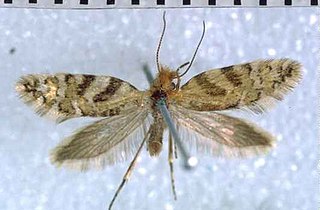
Sabatinca aenea, also known as the Banks Peninsula Metallic, is a species of moth belonging to the family Micropterigidae. This species was first described by George Hudson in 1923. It is endemic to New Zealand and is found in Kaikōura and in the Canterbury regions. The larvae of this species is a deep grey green colour and likely feeds on foliose liverwort species. The adult moths likely feed on fern spores or sedge pollen. This species prefers moist semi-shaded habitat and the adults are on the wing from the start of October until the middle of December.

Sabatinca calliarcha is a species of moth belonging to the family Micropterigidae. It was described by Edward Meyrick in 1912. It is endemic to New Zealand. It is found in two separate areas of New Zealand - the first in the northern parts of the North Island including Great Barrier Island and the second population can be found from the top of the South Island down to Southland. The adults of the species are on the wing from the end of September until the middle of January. The species prefers to inhabit damp forests and larvae likely feed on leafy liverwort species. Adult moths likely feed on the spores of ferns or the pollen of sedge grasses.
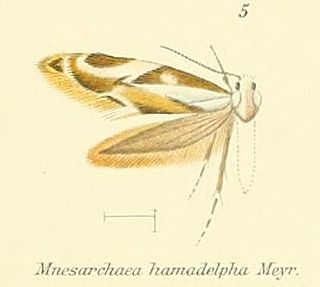
Mnesarchella hamadelpha is a species of primitive moth in the family Mnesarchaeidae. It is endemic to New Zealand and is found in the Wellington, Marlborough Sounds, Marlborough and Nelson regions. It is frequently found at altitudes of between 800 and 1400m but can be found as low as approximately 400 m. It is often found in damp moss covered but well lit native forest. This species is very similar in appearance to M. acuta. However although M. hamadelpha is present in the same locations as M. acuta, it is usually found at higher altitudes or at later times in the year. Adults are on the wing from November to February.
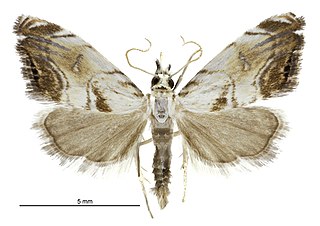
Glaucocharis harmonica is a moth in the family Crambidae. This species was described by Edward Meyrick in 1888. It is endemic to New Zealand and is found in the North and South Islands. It inhabits lowland to subalpine native forest. It has been hypothesised that there are two broods per year. The larval hosts are unknown. Adults are on the wing from October until January.
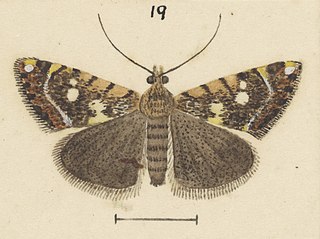
Glaucocharis planetopa is a moth of the family Crambidae. It was first described by Edward Meyrick in 1923. It is endemic to New Zealand and has only be observed on the South Island. G. planetopa inhabits native forest. Larvae of Glaucocharis species feed on mosses and liverworts. Adults are on the wing in January and February. As at 1971 the female of this species had yet to be collected.

Glaucocharis pyrsophanes is a moth in the family Crambidae. It was described by Edward Meyrick in 1882. It is endemic to New Zealand and is found throughout the country including the North, South and Stewart Islands. It inhabits native forest from lowland and subalpine altitudes. It is said to be common in sunny but damp forest openings. Larvae of Glaucocharis species feed on mosses and liverworts. Adults are on the wing from October until February. They are known to feed from and pollinate Leptospermum scoparium and Helichrysum selago.

Pyrgotis eudorana is a species of moth of the family Tortricidae. It is endemic in New Zealand and has been observed in both the North and South Islands. However it is regarded as a rare insect. This species inhabits native forest. Larvae exclusively feed on Muehlenbeckia australis and adults are on the wing from November to April. Adults are attracted to light.

Trachypepla lichenodes is a moth of the family Oecophoridae first described by Edward Meyrick in 1883. It is endemic to New Zealand and has been found in both the North and South Islands. It inhabits native forest and adults of this species are on the wing from November to January. The adult moths are similarly coloured to native lichen species however this colouration is variable in the extent and depth on the forewings.

Trachypepla protochlora is a moth of the family Oecophoridae first described by Edward Meyrick in 1883. It is endemic to New Zealand and is found in both the North and South Islands. The preferred habitat of this species is native forest and adults are on the wing from October until February. Adults can be variable in their green shaded colour as well as in the intensity of markings on their forewings. The greenish ground colouration of this moth ensures they are well camouflaged when at rest on green mosses and lichens.
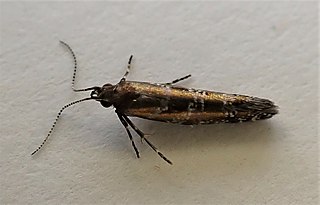
Chrysorthenches drosochalca is a species of moth in the family Plutellidae first described by Edward Meyrick in 1905. It is endemic to New Zealand and has been found in the North and South Islands. The larvae are leaf miners of Prumnopitys ferruginea. Adults are on the wing from January to March.






















